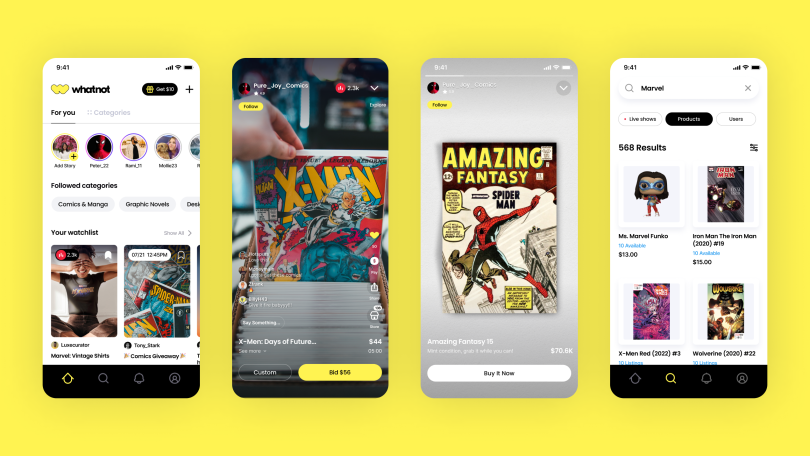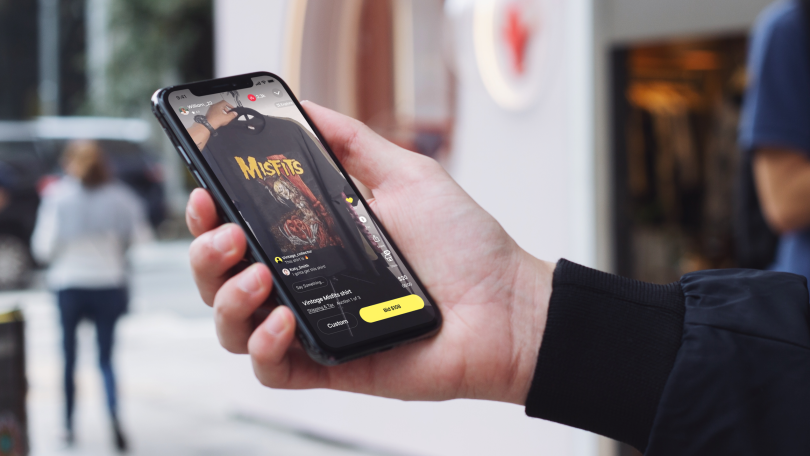Imagine you’re on the prowl for an elusive Funko Pop! Your local collectible shop has given you the cold shoulder ever since you scoffed at the proprietor’s overpriced George Costanza Pop! So you take to the internet. Halfway through your query, you encounter a channel with dozens of sellers — Funko enthusiasts — streaming live. They’re offering deep discounts, rare gems and even giveaway packages.
You pull back and find baseball cards, Marvel memorabilia, vintage clothes, die-cast cars, Manga, personal electronics, artisan housewares and even NFTs. Enthusiasts from all avenues of the internet are coming together to buy, sell and celebrate the collectibles they love.
This is the vision behind Whatnot — capturing the excitement of the in-person collector experience and coupling that excitement with the convenience of an online marketplace.
Co-founder and CEO Grant LaFontaine has called the platform “Twitch meets Ebay” — a combination of popular personality-driven streaming entertainment and a digital marketplace. Begun in 2019 as a traditional asynchronous Funko Pop! sales platform, Whatnot’s founders LaFontaine and Logan Head quickly realized the potential application of the increasingly popular livestream format to the retail market. And they started to build a product that could leverage live streaming to connect buyers and sellers in their marketplace.
“Logan and I have been buying and selling collectibles online since the early days of the internet. And while others might be surprised by the attention the category has received in the past year, we are tapping into a community we’ve always known was there,” LaFontaine said in a press release last May. “We’re thrilled that Whatnot has resonated with the collector and enthusiast communities.”
In 2020, the platform expanded to Canada — and to new categories. Collectors of comics, cards, sports memorabilia and other collectibles — both physical and digital — were soon able to take advantage of Whatnot’s fast-growing platform. Ultimately, Whatnot has its sights set on expanding to every category imaginable. And the company is currently pursuing a high-growth trajectory as it builds to take advantage of the burgeoning livestream retail market.

Abounding in Opportunities
According to McKinsey, livestream retail currently accounts for roughly 10 percent of e-commerce sales in China. Worldwide, the market for livestream retail is doubling year over year as more consumers are drawn into these communities. The consulting firm estimates that the livestream channel could account for as much as 10 to 20 percent of global e-commerce sales as early as 2026.
In an effort to stay atop this rapidly growing market, Whatnot has been ambitiously scaling. The company — which had roughly a dozen employees at the start of 2021 — has expanded from modest beginnings to an organization of more than 120. It plans to more than double that number by the end of the year.
What’s more, Whatnot has raised more than $480 million to date. The company counts prominent investors like Andreessen Horowitz, Y Combinator and BOND as stakeholders. This June, Whatnot announced the close of its most recent round of funding — a $260 million Series D co-led by DST Global and CapitalG, Alphabet’s independent growth fund. That round of funding raised the company’s valuation to $3.7 billion — a unicorn nearly four times over.
Serving the Sellers
Whatnot hasn’t just been lucrative from a fundraising standpoint, though. It’s also been an engine for many of its community members to develop wealth. While some users might be engaged in buying and selling as a hobby, the opportunity to sell products on Whatnot’s platform has helped some collectible enthusiasts turn an erstwhile personal passion into a thriving business.
“I’ve been working in esports for years and buying and selling childhood favorites like Pokémon and sports cards as a fun side hustle on nights and weekends,” Whatnot seller Roger Caneda of World Card Traders told the company last year. “What began as a passion project has become a full-time gig. We now have five people on the team and have leased office space to ensure we can continue to produce high-quality shows, auctions and ‘cardbreaks’ on Whatnot. Without Whatnot, turning my passion into a full-time business would never have been possible.”
According to company data, users who livestream on Whatnot earn an average of $6,000 each month. They have the opportunity to network with hundreds of thousands of users. The platform has been a boon for many collectible sellers — as well as artists and artisans selling their products to fans.
“Whatnot has been absolutely game changing for me,” Tyler Kirkham said in a Whatnot testimonial. As an artist working with Marvel, DC and other prominent publishers, Kirkham has illustrated some of the biggest names in comic books, including Spider-Man, Captain America, Hulk, Batman and Green Lantern. He is also the creator-owner of his own comic book property “Final Boss.”
“It’s been an amazing place to reach new fans and collectors,” Kirkham said. “It’s by far the best way to sell comics and collectibles online. The format and community makes it extremely exciting and engaging for sellers and buyers.”
And while the majority of the artwork and collectibles that Whatnot sells are physical in nature, the company’s recent expansion into the NFT market also provides sellers with a place to break into the digital marketplace.

A New Digital Frontier
In a Medium post entitled, “How Whatnot is building the future of NFT live shopping,” Rob Olsthoorn, NFTs, recently broke down the Whatnot’s guiding principles, strategy and the vision for the future of NFTs on the company’s live-shopping platform.
“Thousands of new buyers have purchased their first NFT ever through Whatnot, and about 30 percent continue on to become collectors,” Olsthoon said. “Over time, many of these new collectors deeply understand the blockchain and NFT mechanics.”
In the same sense that Whatnot’s platform is designed in part to create greater community around physical collectibles, the company’s inclusion of NFT’s is intended to foster a safe and trustworthy marketplace for digital collectors built around products that are more than a money-making scheme.
Whatnot is sensitive to the criticism that NFTs have faced. While noting that Ponzi schemes, fraudulent products and other scams have plagued the NFT space, Olsthoorn predicts that the excesses of the NFT market will give way to sustainable conditions as consumers become more attuned to the contours of the market, the communities in which buying and selling occurs and the value proposition intrinsic in NFT projects.
“We’ve cautiously added NFT projects — and stayed away from primary mints — to protect new buyers coming into the NFT space,” Olsthoon said. “Long term, we believe NFTs will be far more transparent. The era of NFT flipping is coming to an end, and in its place are projects with intrinsic value.”
The ultimate vision for Whatnot is to leverage its platform to help digital collectors develop a greater sense of community and a broader audience.
“While it’s still early today, the vision is that ultimately creators — artists, influencers, anyone — will be able to sell and creatively engage with digital items on Whatnot, and collectors will be able to buy, collect, show off, trade, re-sell and interact with these digital items,” Olsthoorn said. “Whatnot can provide a collector-focused experience for NFTs with the interface already known and loved by so many sellers. It’ll be a place digital artists love to come and sell their work to a broad audience, through an experience that’s easy for everyone from experts to NFT newcomers.”
The Sky’s the Limit
With expansive goals, a novel product, the confidence of the investor community, a growing team of enthusiastic employees and a community of equally enthusiastic users, Whatnot is ready to challenge the e-commerce status quo and vie for the prize that is predominance in the North American livestream retail market.
“The race to ‘win’ livestream shopping in the U.S. has been heating up over the past few years and with the investments we’ve made in our platform, sellers and audience, we are ready to take over,” LaFontaine said in a press release. “In partnership with our existing investors and CapitalG, we are armed with the capital needed to continue to grow and hire at the pace we need to maintain our position as the largest livestream platform in the United States.”





